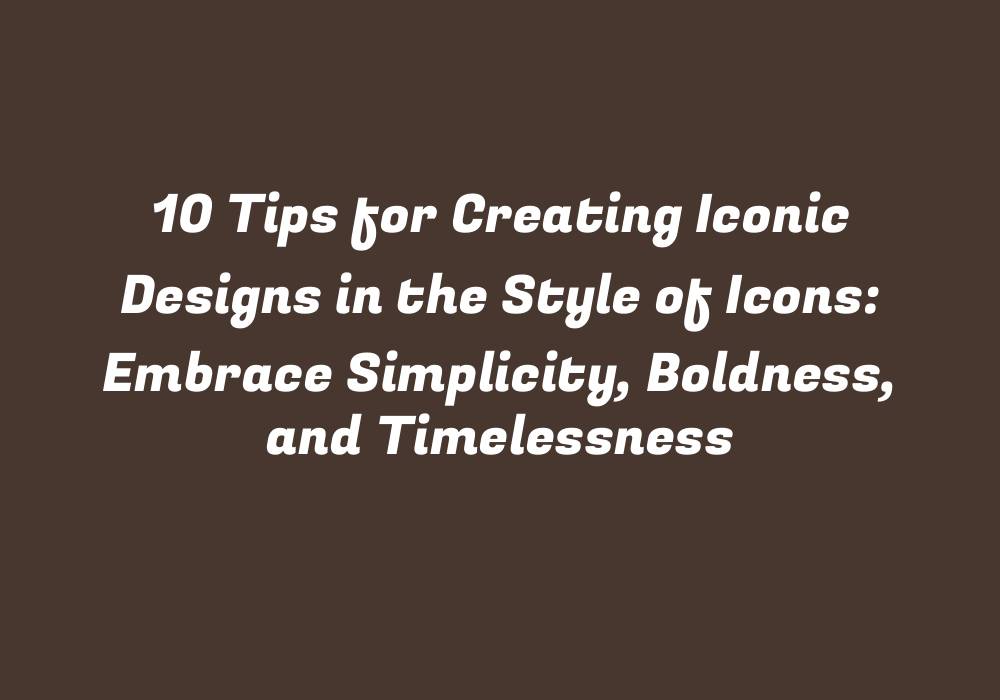Introduction
Designing iconic works in the style of icons is an art form that requires mastery, patience, and a deep understanding of what truly makes a design memorable. Iconic designs have become symbols of their respective eras, transcending cultural differences and inspiring generations to come. In this article, we will explore ten tips on how to create iconic designs inspired by the icons themselves – embracing simplicity, boldness, and timelessness to leave an everlasting mark in the world of art and design.
1. Embrace Simplicity
An icon’s power lies not only in its aesthetic appeal but also in its ability to communicate a clear message with minimal complexity. Simplify your ideas to create designs that evoke emotion, trigger thought, or inspire action from those who experience them. Strip away any unnecessary elements to ensure your design retains its impact and remains memorable for years to come.
2. Understand the Power of Negative Space
The balance between what is present in a design and what is left out plays an essential role in creating iconic pieces. Negative space allows for visual breathing room, making it easier for viewers to focus on the central elements while leaving room for interpretation. Use negative space to your advantage by incorporating it into the design’s composition or even using it as the main focal point.
3. Pay Attention to Typography
Typefaces play a crucial role in iconic designs, providing an opportunity for creativity and innovation. Choose font styles that complement the overall look and feel of your work while ensuring legibility. Consider typographic variations like bold, italics, or uppercase letters to create visual interest without compromising clarity.
4. Boldness is Key
Boldness in design means taking risks and making decisions that push boundaries. Iconic designs often possess a sense of confidence and originality that can be easily recognized by viewers. Do not shy away from experimentation or unconventional approaches, as these elements help set your work apart from the rest.
5. Explore Color Theory
Color can significantly impact the overall emotion and message conveyed through an iconic design. Familiarize yourself with color theory to better understand how different colors interact and evoke specific feelings in your audience. Choose complementary or contrasting colors that create a visually striking image while remaining harmonious.
6. Contrast is Essential
By incorporating contrast into your design, you can draw attention to specific elements and ensure they stand out among the rest. Combine different textures, materials, shapes, or patterns to create visual tension, making your work more dynamic and engaging for the viewer.
7. Think Beyond Two Dimensions
Iconic designs often transcend limitations by expanding into three-dimensional spaces. Consider how your design can be adapted for various applications, such as sculptures, installations, or product design. By incorporating depth and multiple dimensions, you can enhance the overall impact of your work, making it more memorable for onlookers.
8. Focus on Storytelling
Storytelling through iconic designs is an effective way to connect with viewers on a deeper level and encourage a lasting emotional attachment. Infuse emotion, meaning, or narrative elements into your design, allowing people to relate their own experiences and create personal connections with the piece.
9. Adaptability
One of the essential qualities of iconic designs is their ability to evolve over time while retaining their original essence. Be open to adapting your work in response to changing contexts or circumstances, without losing sight of its core message. This adaptability ensures that your design remains relevant and resonates with a broader audience.
10. Seek Feedback and Refine
Refining your skills and understanding of what constitutes an iconic design requires constant learning and growth. Engage in critical self-analysis, seek constructive feedback from others, and regularly revisit your work to identify areas for improvement. This iterative process will strengthen your ability to create designs that resonate with viewers, leaving a lasting impact on the world of art and design.
Conclusion
Iconic designs have the power to inspire generations and transcend cultural barriers by embracing simplicity, boldness, and timelessness in their composition. By following these ten tips, you can take your creative endeavors to new heights, leaving an indelible mark on the world of art and design. Always be willing to experiment, learn from others, and refine your craft to create pieces that not only capture attention but also evoke a powerful emotional response in those who experience them.
